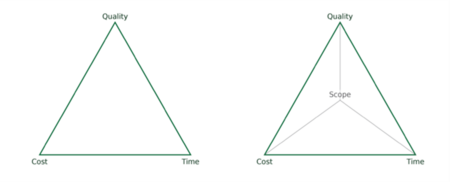Design thinking
Contents |
Abstract
Design thinking is understood as an approach to implement creativity into problem-solving areas and develop new ideas. To address problems, a combination of creative techniques and the consideration of business factors such as the inclusion of stakeholders and the conversion capability of the idea into the company are used. [1]
1969, Herbert A. Simon first brought up the idea of design as a way of thinking in his book with the title ‘Sciences of the Artificial’. 1990 the process of design thinking was developed by the design school of Stanford and the design and innovation company IDEO was established to communicate it to the market. [2]
The approach consists of 5-coordinated phases where the focus is on the customer and its benefit, well-being and needs. In doing so, it is important to involve them already at an early stage to identify their real problems and continuously draw the conclusion to them.[3]
The basis is built by an interdisciplinary team with members out of different fields, departments and hierarchical levels which differs in their experience, background, and point of views. One main method of design thinking is the use of abductive thinking which means that the problem needs to be recognized with observations. Instead of the common way to build up a solution for the problem, it is more about first identifying the problems which disrupt the customer's well-being and as a next step to search for possible solutions. Team members are asked to challenge themselves with thinking outside the box. [4]
The purpose of this article is to focus on the basic concepts of the design thinking process as well as its opportunities and threats. Furthermore, it will indicate how Design Thinking can have an impact on the success of project management and how to implement it successfully into the project management of a company.
The design thinking process
The process developed by IDECO is the 5-step model of Design thinking. It is based on the primary process of Herbert Simon of 1969 with 7 steps.[2]

Empathize
The focus in this phase lies on getting a deep understanding of the problem and the people that will be addressed through a real-world observation. It is the basis of a human-centred process. Observing, analyzing people’s behaviour and engaging with them directly are essential to build empathy for particular users and to gain insights of its experiences. The goal is to identify the users to conceive for and to come across new ideas and fields of action the designer didn’t have on the scope before which these customers really need. It might be challenging for designers to look over the process from an untouched perspective which is fundamental to find new innovations. [3]
Define
The outcome is the formulation of the problem statement as a challenge for the innovation based on the discoveries of the previous phase combined with the observer's point of view as a unique design vision. This step is really important because it defines a specific customer need which the solution needs to satisfy. A beneficial point of view needs to give the project a design frame, a guideline for the innovation effort and captures people which are involved in the project.[3]
Ideate
At this stage, the user's needs are understood and the human-centered problem statement is defined. Next step is to think 'outside the box' and generate ideas to solve the problem. At the beginning, it is important to find as many ideas as possible with a varied range: any idea which first seems to be absurd needs to be reflected. The tool which is often used to collect ideas, is the Brainstorming.[2] There are also several other methods but the crucial criterion is that the collection and the evaluation of ideas need to be separated from each other. The widening of mindset can be enhanced by working with an interdisciplinary team of workers that have lots of ideas in mind and that are willing to build upon an other's idea. This increases the innovation potential of the collection of the solution.[3]
Prototype
The aim of this phase is to bring the ideas into a physical form to see at an early stage if the theory can work in reality. Uncovering a failure of an idea at an early stage saves valuable resources. IDECO recommends, for instance, a wall of post-it notes, a role-play, an object, or also a storyboard as potential prototypes. The prototype itself changes during the project time. At the beginning, it is simply designed to allow the creation of multiple prototypes. With the growth of the idea over the time period, the prototype becomes more detailed. However, the prototype should represent the situation to receive feedback from future customers and stakeholders as well as to uncover possible weaknesses of the idea. Other than testing, it is also used to gain empathy for the customer's point of view, to explore alternative options for solutions and to inspire people for the idea.[3]
Testing
Testing is understood as the evaluation of the finalised product. As well as during the previous phases, the future customer shall be included. The outcome is to refine the prototype and include the critiques of the customer or even to redefine the problem if the wrong goal was reached.[3]
The iterative nature of Design Thinking
Design Thinking within Project Managment
Key Factors for successful implementation
Advantages
Limitations and Challenges
Forecast
References
- ↑ Johansson-Sköldberg, U.; Woodilla, J.; Çetinkaya, M.(2013): Design Thinking: Past, Present and Possible Futures.
- ↑ 2.0 2.1 2.2 Design Thinking: Get a Quick Overview of the History website of International Design Foundation. Last access on 5.Feb
- ↑ 3.0 3.1 3.2 3.3 3.4 3.5 Plattner, H.bootcamp bootlegInstitute of Design at Stanford
- ↑ Vianna, M.; Vianna, Y.; Adler, I.K.; Lucena, B.; Russo, B.(2012)Design Thinking - Business Innovation
- ↑ http://taniacruz.com/save-time-with-design-thinking/